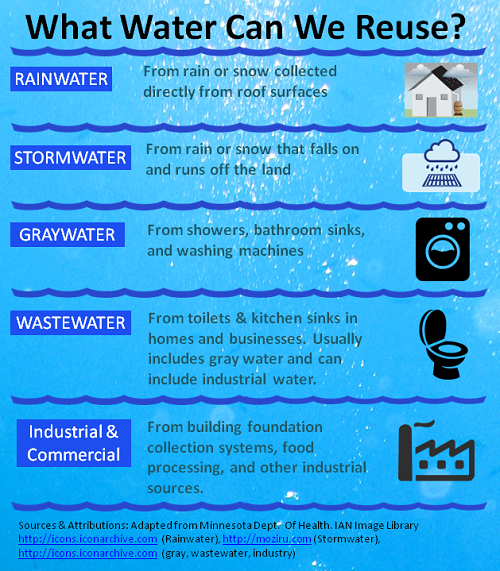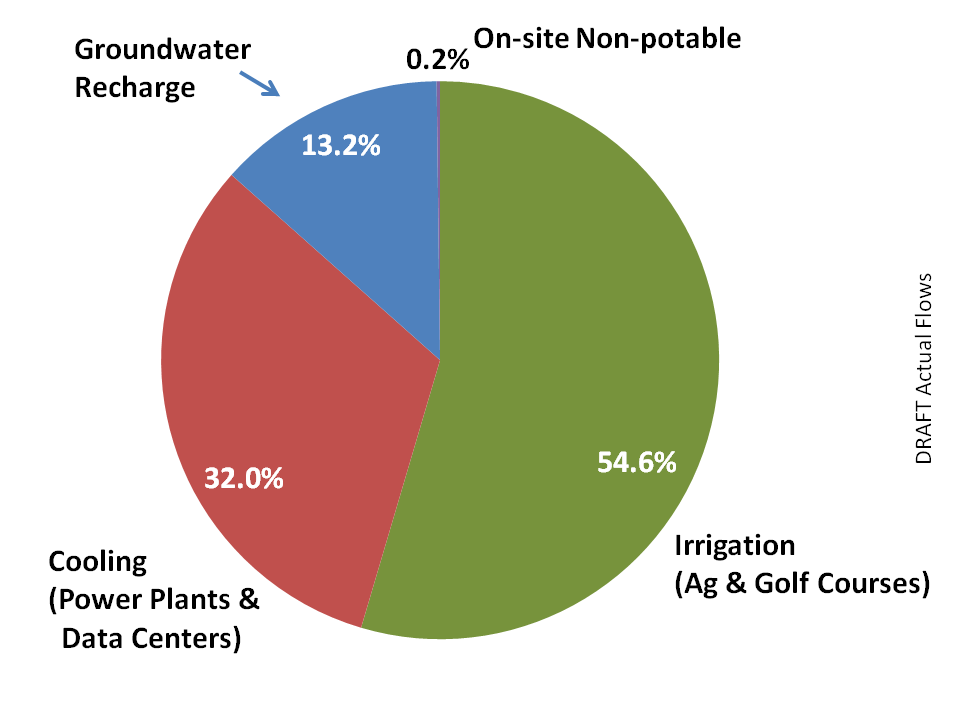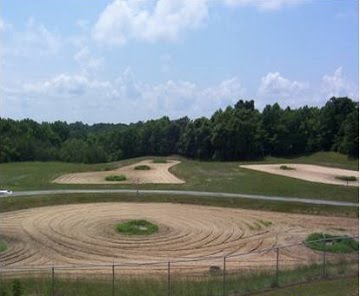What Water Can We Reuse?
A Summary of Water Available for Reuse is a Good Starting Point
The graphic below lists the types of water that are available for reuse.

Rainwater collected from rooftops is cleaner than stormwater, because stormwater has run across the ground and become dirtier. Similarly, graywater from showers, bathroom sinks and washing machines is considered to be cleaner than wastewater, sometimes called blackwater, from toilets and kitchen sinks. Usually, graywater and wastewater are mixed after they go down the drain and leave our homes or businesses, so they don't seem very different. The differences become more important if we want to reuse the water.
Helpful Background
Some Basic Background is Helpful to Understand the Different Ways Water can be Reused
Two very basic questions to ask about our water are,
- Water Supply: Where do we get our clean water from? and
- Water Disposal: Where do we dispose of our used water?
The most common answers to these two basic questions depend on the geographic setting. In a rural setting, depicted in Figure 1, the water supply is typically from an individual well. Water disposal is typically accomplished via a septic system; whereby, the used water drains into the ground in an underground drain field after solids are settled out in a tank.
When many homes and businesses are spread across an area using individual wells and septic systems, the situation is described as a distributed system. This is in contrast to a centralized system described immediately below.
 Figure 1 - Typical rural setting in which water is supplied by an individual well and the used water is disposed of via a septic system.
Figure 1 - Typical rural setting in which water is supplied by an individual well and the used water is disposed of via a septic system.
In more urbanized settings, depicted in Figure 2, the water is typically from a water supply facility, which withdraws water from a river, reservoir or groundwater, treats it and distributes it through a network of pipes to many businesses and residences in the vicinity. Water disposal is typically accomplished via a sewer system; whereby, a network of pipes collects the used water and transports it to a wastewater treatment plant before it is discharged to a nearby waterbody.
 Figure 2 - Typical urban setting in which water through a network of pipes from a water supply facility and the used water is disposed of via a wastewater treatment facility.
Figure 2 - Typical urban setting in which water through a network of pipes from a water supply facility and the used water is disposed of via a wastewater treatment facility.
Broad Categories of Reuse
Organizing the Different Kinds of Reuse Helps to Make Sense of this Issue
Water reuse includes many forms. A simple way to think about the different forms is shown in Figure 3.
The two categories, Potable versus Non-potable, refer to whether or not the reuse is for potable purposes such as drinking, cooking, hand-washing or bathing. Non-potable uses include the many other types of uses, some of which are described below.
The Potable category is further divided into Direct Potable and Indirect Potable. Direct Potable use refers to wastewater that is highly treated then directly used for potable purposes. Indirect Potable use refers to wastewater that is treated and discharged to surface water bodies or groundwater aquifers that serve as sources of potable use.
The two categories, Centralized versus On-Site, refer broadly to the situations described earlier for centralized and distributed water supply and wastewater systems. Centralized reuse aligns with the more urbanized setting in which wastewater is collected in a network of sewer pipes and sent to a centralized treatment facility. The treated wastewater can, in principle, be used for potable or non-potable purposes.
The On-site situation typically refers to reusing graywater or rainwater at the location it is generated. Although this aligns with the rural setting with distributed individual water supply wells and septic systems, homes and businesses in urban settings can also practice on-site reuse.
 Figure 3 - Broad Categories of Water Reuse
Figure 3 - Broad Categories of Water Reuse
Examples of Water Reuse in Maryland
Maryland is Already Reusing Water
 Percentages of Major Types of Water Reuse in Maryland
Percentages of Major Types of Water Reuse in Maryland
By volume, the three dominant types of reuse in Maryland are irrigation, cooling water and groundwater recharge. These are all in the category of centralized non-potable reuse, which corresponds with the upper right corner of Figure 3.
Irrigation
Irrigation with treated wastewater in Maryland includes cropland, golf courses and some forested land. Irrigation with reclaimed water can benefit water users by providing a reliable source of water, particularly during times of low rainfall. The water also tends to have consistent quality and might cost less than other options.
Benefits to broader society include cleaner lakes and rivers water due to reduced wastewater discharges. Reuse of treated wastewater can conserve groundwater that is often used for irrigation. Although the pie chart of major types of water reuse in Maryland separates irrigation from groundwater recharge, irrigation with treated wastewater also helps to recharge groundwater. This can benefit streams and springs that are fed by groundwater.
 Spray Irrigation System in Worton, Maryland
Spray Irrigation System in Worton, Maryland
Irrigation with reclaimed water in Maryland is used for crops that are not consumed by humans. The vast majority of irrigation in Maryland uses spray systems. A small fraction uses drip irrigation systems. Drip irrigation systems typically cost more than spray systems, because piping has to be laid throughout the fields. However, drip irrigation systems typically use less water because the water is delivered more effectively to the roots.
 Brandon Shores Power Generating Facility
Brandon Shores Power Generating Facility
Cooling Water
Cooling of electric generating power plants and computer centers are two other significant uses treated wastewater effluent in Maryland. Two power plants in Maryland are currently permitted to use up to about 3 million gallons per day of treated effluent primarily for their cooling processes. The Panda-Brandywine facility in Charles County uses effluent from the Mattawoman wastewater treatment plant (WWTP). The Brandon Shores facility in Anne Arundel county uses effluent from the Cox Creek WWTP. The Brandon Shores facility also uses reclaimed water in its wet flue gas desulfurization process for air pollution control.
Federal computer server centers are permitted to use up to 5 million gallons per day of treated effluent from the Little Patuxent WWTP in Howard County, although current us is a small fraction of that amount.
 Rapid Infiltration Basin, Solomons Island, Calvert County
Rapid Infiltration Basin, Solomons Island, Calvert County
Groundwater Recharge
Groundwater recharge has been mentioned as an incidental benefit of reusing treated wastewater effluent for irrigation. However, direct groundwater recharge is itself a separate category of reuse in Maryland. The motivation is primarily to protect surface water quality; however, other benefits are noted above, as well as the benefit of preventing saltwater from intruding into fresh groundwater sources.
The two main methods of groundwater recharge are rapid infiltration, in which water is spread on the surface of the ground and allowed to soak in, and injection wells, in which the water may be pumped into the ground. Several injection well systems, using treated wastewater, are located in Worcester County. A number of rapid infiltration systems are located in Calvert and St. Mary's County.
Up Next: Innovations in Water Reuse
Because Maryland is a 'water rich' state, other places with scarce water have, by necessity, adopted innovations from which we can learn. In addition, emerging technologies that have not yet been adopted have the potential to create opportunities for Marylanders in the future.
Learn more about Innovations in Water Reuse. (Next Page)
Contact Information
Please direct questions or comments to Jim George.
